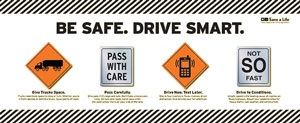Driving is challenging because you need to do many tasks at once. You have to control the vehicle, watch the roadway and off-road areas, read signs and be alert for sudden actions of other drivers.
As younger drivers you probably have good reflexes, especially if you are an athlete or good at certain video games. However, good reflexes alone do not make you a safe driver.
You need to develop visual skills, decision making skills and vehicle handling skills to become a safe driver.
Have you ever heard of the SIPDE process?
The SIPDE process is short for search, identify, predict, decide and execute.
SIPDE is a five step process that includes the following:
- SEARCH the roadway and the off-road area 20 -30 seconds (about a block to a block and a half) ahead for information that can help you plan your path of travel. Use a systematic search pattern to gather information. First search the road ahead, then to the sides, then glance in your rearview and side mirrors.
- IDENTIFY objects or conditions with 12-15 seconds ahead that could interfere with your path of travel. To identify important information as a driver, you must do more than just LOOK. You must think about what you are looking for; things like stalled cars on the side of the road, pedestrians waiting to cross the street, and cars coming up too fast behind you are all important information.
- PREDICT what actions or changes in conditions on or near the roadway could increase your level of risk. As you search the roadway and see the positions of the vehicles and pedestrians, try to predict what you would do in certain circumstances. For instance, the car behind you that is coming up too fast might not be able to stop. You need to think – before that car rear-ends you – in order to make a decision to move to another lane to avoid a crash.
- DECIDE what action or actions to take (such as reduce speed, increase speed, brake or steer clear) 4 to 5 seconds ahead of time to control or reduce risk. Once you have identified a potential threat you can decide how best to minimize the risk of a collision. Keep in mind most situations allow you a choice of actions, such as moving to another lane to avoid a rear-end collision, or taking the ditch to the right rather than taking a head-on hit.
- Execute your decision. The final step is to execute the decision you have made. In most instances, executing a decision simply means making a routine maneuver.
Practicing the SIPDE process during your driver training process will help new drivers become smarter, more defensive drivers. If you have a new teen driver and want to make their behind the wheel practice less stressful and more successful,
click the link below to check out our groundbreaking DVD “Roadworthy – A Parent’s Guide to Teaching Teens to Drive: 12 Lessons to Keep Your Teen Alive Behind the Wheel”





i think that this system will be very helpful to new drivers like me so in this case i know that i will personally be looking back on what this is telling me and how i can better myself when i start driving so i can be as safe as possible knowing what to do and not to do.
Lauren,
So glad you found our article helpful.
We appreciate your interest in becoming a smarter, safer driver.
We are here to help.
The DriveSafeRideSafe Team
Ground breaking video links are not working.
Hi,
I’m not familiar with a video titled “Ground breaking” could be under a different name perhaps?
We are here to help.
The DriveSafeRideSafe Team
I learned S.I.P.D.E. in 2001 or 2002. It’s a great way to keep yourself & your vehicle out of harm’s way. Countless times I’ve predicted correctly what the careless driver in the scene ahead of me would do and then had to act on it accordingly. I really like this tool!
I think that it is a very good way to keep them 5 things in your mind.
I think that it is a very good way to keep them 5 things in your mind.and when people that don’t understand the 5 safety ways they can think of them.
I agree with that